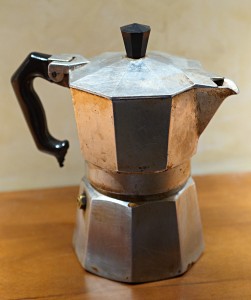Section VIII: Dream Object – Repressed Associations Required for Proper Functioning
Upon hearing that we were to create and share Surrealist objects for precept mid-semester, I took measures to have more lucid dreams (dream recall, dream journaling, etc.) in the hopes that I would identify a dream object that I could recreate and interpret for the assignment. Ultimately, I observed and remembered not just a dream object, but an entire scene centered around one. Although I was not able to interpret the object’s significance in time for precept, I have since thought a significant amount about the dream object, and I am confident in my interpretation of the associations that underlie the scene…
I found myself in front of the sink in a modern kitchen, one that, for reasons still not entirely clear to me (perhaps because the dream was experienced similarly to a movie), was reminiscent of the kitchen in the movie Gone Girl, as pictured below.
Like this, except without the cat or the woman, and the dream’s perspective was from behind the sink
Desiring coffee, I found an antique stovetop espresso maker in my hand, of the sort I encountered only during my time as a tourist in Italy. With the lid opened, I noticed that instead of coffee grounds that would produce coffee upon being boiled, the pot was filled with glimmering metal rinds, as if a number of aluminum cans had been ground down and poured in. Not thinking anything of the unusual contents, I placed the opened pot under the spout of the sink and turned on the sink to pour water over the metal, as one would usually do to create coffee from coffee grounds using an antique pot. However, after filling the pot with water and stepping away from the sink, I looked into the pot and found what were originally metal rinds replaced with burnt coffee grounds. My confusion was short-lasted, as my dream (or at least my memory of it) ends there.
Despite its short length, the dream scene incorporated a number of the components of Surrealist objects. For example, the placement of metal rinds in the coffee pot constitutes an unusual pair of objects brought into context with one another. Additionally, the coffee pot functioning in a manner that differs from its traditional use is consistent with the re-contextualization and deprivation of function found in a number of Surrealist objects.
As with any dream object, the significance of the object in this dream scene lies in the associations that underlie it. Because the metal rinds replaced what I would have utilized to extract caffeine with which to energize myself and make myself more efficient, they can be considered to represent two things. First, the rinds constitute my reliance on caffeine in order to be more efficient. Second, the metal nature of the grounds represents the level of efficiency I desire to achieve: that of machines, the (generally metallic and) most efficient creations of mankind. This idealization of machines and the efficiency of automatism is a common theme of Surrealist works, reflecting the artists’ belief that everyday life lived according to societal norms is devoid of agency and limited in perspective, making us no different than the automatons we sought to emulate. For me, the unusual combination of these associations revealed that my reliance on caffeine is externally motivated, as it is societal expectations of efficiency that influence me to consume the drug.
However, rather than producing a concoction that would multiply my productivity, my preparation of the metal grounds only resulted in burnt coffee grounds. Here, my exposing the metal rinds to running water in order to prepare them for the production of coffee mirrors the strain I put myself through to prepare myself for a future as an efficient, productive member of society. However, the prepared metal never reached the stage of production, being converted into burnt, bitter, unusable coffee instead. This can be interpreted as a warning or indication that my efforts to make myself more efficient backfire and ultimately contribute to my own “burning out,” or exhaustion to the point of inefficiency and non-functionality. Because the desire to be more efficient is a prevalent one in modern society, the implications of the dream object I encountered extends beyond me and can be generalized to society as a whole. So long as we continue to increase our reliance on efficiency-enhancing stimulants in response to our continued idealization of machines, we are only expediting the process of becoming nonfunctional and automatic beings that are burnt out and lack pleasure. As I conclude this analysis, it is evident to me that the identity of the coffee pot as an artifact I encountered only as a tourist brings to mind Radiohead’s The Tourist, a song that documents the burning out of a man who “sometimes [gets] overcharged… that’s when you see sparks” and experiences life “at a thousand feet per second” (1997). In other words, over-exhaustion from racing through life and attempting to perform at an inhuman rate is only bound to leading to malfunctioning, similar to the burning out suggested in my dream. The only solution to this predicament, it seems, is the same advised by Radiohead at the song’s end: “Hey man, slow down, slow down” (ibid).

